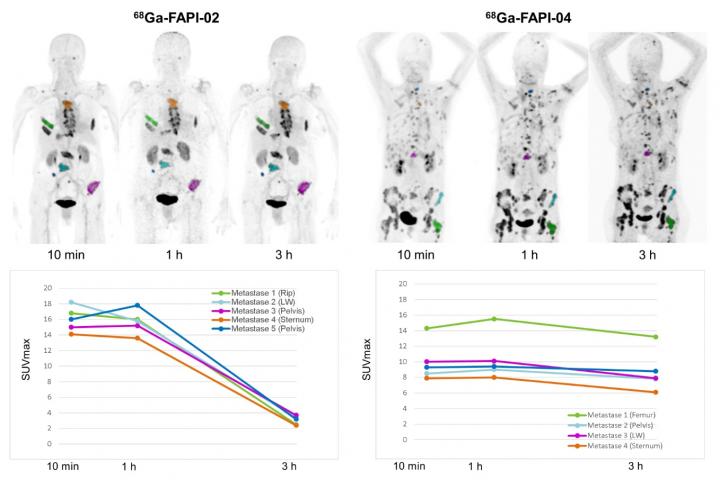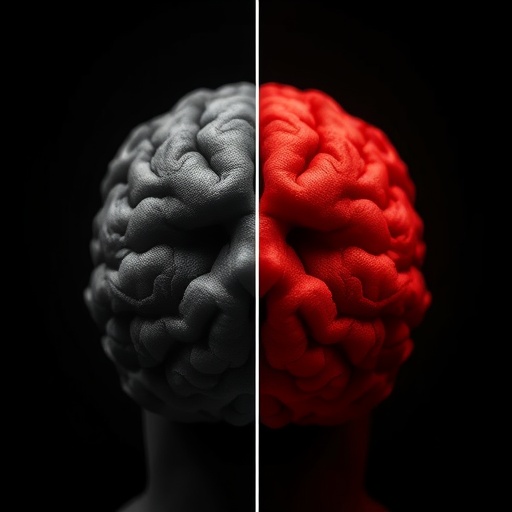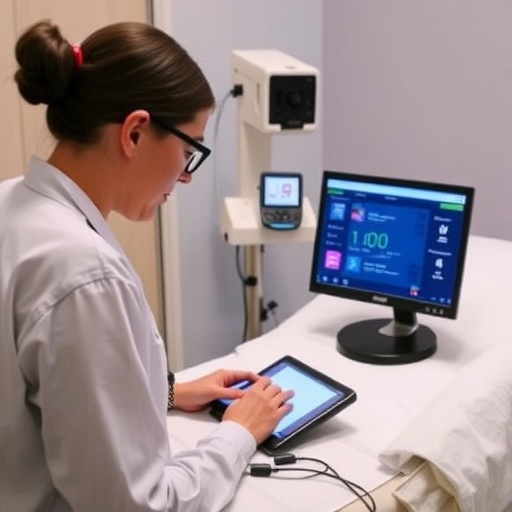
Credit: Giesel FL, Kratochwil C, Lindner T, et al.
Researchers have identified two new nuclear medicine tracers that make it easier to diagnose and potentially treat cancer. A proof-of-concept investigation, published in the March issue of The Journal of Nuclear Medicine, reports that 68Ga-FAPI positron emission tomography/computed tomography (PET/CT) provides high-contrast images with quality equal to or better than that of the standard 18F-FDG imaging. Further, no diet changes or fasting are needed before beginning imaging with 68Ga-FAPI, and image acquisition times are substantially shorter than with 18F-FDG PET/CT.
“Having an additional diagnostic tool opens up a new door for cancer patients,” said Uwe Haberkorn, MD, professor of nuclear medicine at the University Hospital of Heidelberg and the German Cancer Research Center in Heidelberg, Germany. “For those who are facing unmet diagnostic challenges–unclear tumor segmentation for radiation therapy, suspicion of false-negative findings, or selection of last-line experimental treatment–68Ga-FAPI may help to provide answers.”
In processes involving remodeling of tissue (e.g., wound healing), cells called fibroblasts are activated by several factors, including TGF?? leading to the expression of the fibroblast activation protein (FAP). This protein is produced in abnormally large amounts in cancer-associated fibroblasts (CAFs), which promote tumor growth, migration and progression. 68Ga-FAPI is a new class of radiopharmaceutical that can precisely target CAF activity to aid physicians in diagnosis of cancer. As CAFs are present in more than 90 percent of epithelial carcinomas–including, for example, breast, lung, colon, pancreatic, and head and neck cancers–they are an attractive target for both diagnostic imaging and therapy.
The 50 patients in this analysis were referred by oncologists who were facing unmet diagnostic challenges that could not be solved sufficiently with standard diagnostic means. All patients tolerated the examination well, and no patients reported any symptoms. The favorable characteristics of the new tracers include fast kinetics that seem appropriate for imaging patients even less than 1 h after injection; low background uptake in liver, oral mucosa, and brain; and independence from blood sugar.
Patients benefited from needing no diet changes or preparation for the PET/CT imaging. “A shorter waiting time and shorter scan time can increase patient comfort, which can be especially important for sick patients,” Haberkorn stated. “The possibility of early imaging–for example, after only 10 minutes instead of an hour–could also play a part in simplifying clinical workflow.”
Since CAFs are genetically more stable than cancer cells, they are less likely to develop resistance to therapy. Also, as the FAPI tracers contain the universal DOTA-chelator, a theranostic approach seems feasible.
“FAPI tracers are a promising avenue for cancer treatment,” Haberkorn noted. “What’s more, in the future FAPI imaging may also be used to assess and manage cardiac diseases or fibrotic diseases of the lung, liver and kidneys.”
###
The authors of “68Ga-FAPI PET/CT: Biodistribution and Preliminary Dosimetry Estimate of 2 DOTA-Containing FAP-Targeting Agents in Patients with Various Cancers” include Frederik L. Giesel, Clemens Kratochwil, Thomas Lindner, Manfred M. Marschalek, Anastasia Loktev, Paul Flechsig, Annette Altmann and Walter Mier, Department of Nuclear Medicine, University Hospital Heidelberg, Heidelberg, Germany; Wencke Lehnert, ABX-CRO Advanced Pharmaceutical Services Forschungsgesellschaft m.b.H, Dresden, Germany; Jürgen Debus, Department of Radiation Oncology, University Hospital Heidelberg, Heidelberg, Germany, and Clinical Cooperation Unit Radiation Oncology, German Cancer Research Center, Heidelberg, Germany; Dirk Jäger, Department of Medical Oncology, National Center for Tumor Diseases, Heidelberg, Germany; and Uwe Haberkorn, Department of Nuclear Medicine, University Hospital Heidelberg, Heidelberg, Germany, Clinical Cooperation Unit Nuclear Medicine, German Cancer Research Center, Heidelberg, Germany, and Translational Lung Research Center Heidelberg, German Center for Lung Research, Heidelberg, Germany.
For more information or to schedule an interview with the researchers, please contact Rebecca Maxey at (703) 652-6772 or [email protected]. Current and past issues of The Journal of Nuclear Medicine can be found online at http://jnm.
About the Society of Nuclear Medicine and Molecular Imaging
The Society of Nuclear Medicine and Molecular Imaging (SNMMI) is an international scientific and medical organization dedicated to advancing nuclear medicine and molecular imaging, vital elements of precision medicine that allow diagnosis and treatment to be tailored to individual patients in order to achieve the best possible outcomes.
SNMMI’s more than 17,000 members set the standard for molecular imaging and nuclear medicine practice by creating guidelines, sharing information through journals and meetings, and leading advocacy on key issues that affect molecular imaging and therapy research and practice. For more information, visit http://www.
Media Contact
Rebecca Maxey
[email protected]
Original Source
https:/
Related Journal Article
http://dx.




